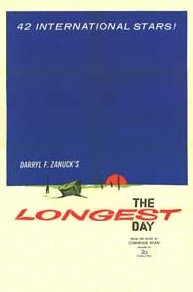
Original movie poster
|
|
| Directed by |
|
| Produced by | Darryl F. Zanuck |
| Screenplay by | |
| Based on | The Longest Day by Cornelius Ryan |
| Starring | |
| Music by | Maurice Jarre (score) Paul Anka (theme) |
| Cinematography |
|
| Edited by | Samuel E. Beetley |
|
Production company
|
Darryl F. Zanuck Productions, Inc.
|
| Distributed by | 20th Century Fox |
|
Release date
|
|
|
Running time
|
178 minutes |
| Country | United States |
| Language |
|
| Budget | $7.75 million |
| Box office | $50,100,000 |
The Longest Day is a 1962 epic war film based on Cornelius Ryan‘s 1959 book The Longest Day (1959), about the D-Day landings at Normandy on June 6, 1944, during World War II. The film was produced by Darryl F. Zanuck, who paid author Ryan $175,000 for the film rights. The screenplay was by Ryan, with additional material written by Romain Gary, James Jones, David Pursall and Jack Seddon. It was directed by Ken Annakin (British and French exteriors), Andrew Marton (American exteriors), and Bernhard Wicki (German scenes). The Longest Day, which was made in black and white, features a large ensemble cast including John Wayne, Kenneth More, Richard Todd, Robert Mitchum, Richard Burton, Steve Forrest, Sean Connery, Henry Fonda, Red Buttons, Peter Lawford, Eddie Albert, Jeffrey Hunter, Stuart Whitman, Tom Tryon, Rod Steiger, Leo Genn, Gert Fröbe, Irina Demick, Bourvil, Curt Jürgens, George Segal, Robert Wagner, Paul Anka and Arletty. Many of these actors played roles that were essentially cameo appearances. In addition, several cast members – including Fonda, Genn, More, Steiger and Todd – saw action as servicemen during the war; Todd was among the first British officers to land in Normandy in Operation Overlord, and he participated in the assault on Pegasus Bridge. The film employed several Axis and Allied military consultants who had been actual participants on D-Day. Many had their roles re-enacted in the film. These included Günther Blumentritt (a former German general), James M. Gavin (an American general), Frederick Morgan (Deputy Chief of Staff at SHAEF), John Howard (who led the airborne assault on the Pegasus Bridge), Lord Lovat (who commanded the 1st Special Service Brigade), Philippe Kieffer (who led his men in the assault on Ouistreham), Marie-Pierre Kœnig (who commanded the Free French Forces in the invasion), Max Pemsel(a German general), Werner Pluskat (the major who was the first German officer to see the invasion fleet), Josef “Pips” Priller (the hot-headed pilot) and Lucie Rommel (widow of Field Marshal Erwin Rommel). A colorized version of this film was released on VHS in 1994, the 50th anniversary of the invasion. The movie won two Academy Awards and was nominated for three others. The movie is filmed in the style of a docudrama. Beginning in the days leading up to D-Day, it concentrates on events on both sides of the channel, such as the Allies waiting for the break in the poor weather and anticipating the reaction of the Axis forces defending northern France. The film pays particular attention to the decision by Gen. Eisenhower, Supreme Commander of SHAEF, to go after reviewing the initial bad-weather reports as well as reports about the divisions within the German High Command as to where an invasion might happen or what the response to it should be. Numerous scenes document the early hours of June 6 when Allied airborne troops were sent in to take key locations inland from the beaches. The French resistance is also shown reacting to the news that an invasion has started. The Longest Day chronicles most of the important events surrounding D-Day, from the British glider missions to secure Pegasus Bridge, the counterattacks launched by American paratroopers scattered around Sainte-Mère-Église, the infiltration and sabotage work conducted by the French resistance and SOE agents to the response by the Wehrmacht to the invasion and the uncertainty of German commanders as to whether it was a feint in preparation for crossings at the Pas de Calais (see Operation Fortitude), where the senior German staff had always assumed it would be. Set-piece scenes include the parachute drop into Sainte-Mère-Église, the advance inshore from the Normandy beaches, the U.S. Ranger Assault Group‘s assault on the Pointe du Hoc, the attack on Ouistreham by Free French Forces and the strafing of the beaches by two lone Luftwaffe pilots. The film concludes with a montage showing various Allied units consolidating their beachheads before they advance inland to reach Germany by crossing France.
- “D-Day: The Great Crusade” (1984) rare 40th Anniversary TV Special
- D-Day 75th anniversary: commemorating the Normandy landings
- Filming ‘the Longest Day’ (1960-1962)
- Longest Day Theme – Instrumental version
- The Longest Day: 75 Things You Don’t Need to Know
- Mitch Miller – The Longest Day
- The City of Prague Philharmonic Orchestra – The Longest Day





































































Comments